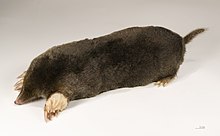Talpa (mammal)
- Machine translation, like DeepL or Google Translate, is a useful starting point for translations, but translators must revise errors as necessary and confirm that the translation is accurate, rather than simply copy-pasting machine-translated text into the English Wikipedia.
- Do not translate text that appears unreliable or low-quality. If possible, verify the text with references provided in the foreign-language article.
- You must provide copyright attribution in the edit summary accompanying your translation by providing an interlanguage link to the source of your translation. A model attribution edit summary is
Content in this edit is translated from the existing German Wikipedia article at [[:de:Eurasische Maulwürfe]]; see its history for attribution. - You may also add the template
{{Translated|de|Eurasische Maulwürfe}}to the talk page. - For more guidance, see Wikipedia:Translation.
| Talpa Temporal range: Miocene to Recent[1] PreꞒ Ꞓ O S D C P T J K Pg N | |
|---|---|
 | |
| European mole (Talpa europaea) | |
| Scientific classification | |
| Domain: | Eukaryota |
| Kingdom: | Animalia |
| Phylum: | Chordata |
| Class: | Mammalia |
| Order: | Eulipotyphla |
| Family: | Talpidae |
| Tribe: | Talpini |
| Genus: | Talpa Linnaeus, 1758 |
| Type species | |
| Talpa europaea[2] Linnaeus, 1758 | |
| Species | |
| See text | |
Talpa[3] is a genus in the mole family Talpidae. Among the first taxa in science,[4] Carolus Linnaeus used the Latin word for "mole", talpa, in his Regnum Animale to refer to the commonly known European form of mole. The group has since been expanded to include 13 extant species, found primarily in Europe and western Asia. The European mole, found throughout most of Europe, is a member of this genus, as are several species restricted to small ranges. One species, Père David's mole, is data deficient. These moles eat earthworms, insects, and other invertebrates found in the soil.
The females of this genus have rudimentary male features such as Cowper's glands and a two-lobed prostate. A group of scientists has suggested that they are true hermaphrodites;[5] however, others state that they are fully functional females.[6]
There are 14 species in this genus:
- Altai mole, T. altaica
- Aquitanian mole, T. aquitania[7]
- Blind mole, T. caeca
- Caucasian mole, T. caucasica
- Père David's mole, T. davidiana
- European mole, T. europaea
- T. hakkariensis[8] Gündüz, Demirtaş, Silsüpür, Özmen, Polly & Bilton, 2023
- Levant mole, T. levantis
- Martino's mole, T. martinorum
- Spanish mole, T. occidentalis
- Ognev's mole, T. ognevi
- Roman mole, T. romana
- Balkan mole, T. stankovici
- Talysch mole, T. talyschensis
In addition, several extinct species are known from fossil remains, here the list:
- †Talpa tyrrhenica T. tyrrhenica
- †Talpa fossilis Petenyi, 1864
- †Talpa praeglacialis Kormos, 1930
- †Talpa minor Freudenberg, 1914
- †Talpa vallesensis Villalta & Crusafont, 1944
- †Talpa episcopalis Kormos, 1930
- †Talpa gilothi Storch, 1978
- †Talpa minuta Blainville, 1840
- †Talpa gracilis Kormos, 1930
- †Talpa neagui Radulescu & Samson, 1989
- †Talpa tenuidentata Ziegler, 1990
- †Talpa sansaniensis Lartet, 1851
The current phylogeny of the species in the genus is shown below:
| Phylogeny of the Eurasian moles according to Demırtaş et al. 2020 [9] |
References
- ^ Benito, C.S.; Martinez, N.L. (1977). "El yacimiento de Escobosa de Calatanyazor (Soria) y su aportacion a la bioestratigraphia del Neogeno de la meseta castellana". In M.T. Alberdi and E. Aguirre (Eds) Round-table on Mastostratigraphy of the W. Mediterranean Neogene Trabajos Sobre Neogeno-Cuaternario. 7. Madrid: 35–40.
- ^ International Commission on Zoological Nomenclature (1922). "Opinion 75. Twenty-Seven Generic Names of Protozoa, Vermes, Pisces, Reptilia and Mammalia Included in the Official List of Zoological Names". Smithsonian Miscellaneous Collections. 73 (1): 35–37.
- ^ Hutterer, R. (2005). "Genus Talpa". In Wilson, D.E.; Reeder, D.M. (eds.). Mammal Species of the World: A Taxonomic and Geographic Reference (3rd ed.). Johns Hopkins University Press. pp. 307–309. ISBN 978-0-8018-8221-0. OCLC 62265494.
- ^ http://upload.wikimedia.org/wikipedia/commons/b/bb/Linnaeus_-_Regnum_Animale_%281735%29.png Table of the Animal Kingdom (Regnum Animale) from Carolus Linnaeus's first edition (1735) of Systema Naturae
- ^ Sánchez, A; Bullejos, M; Burgos, M; Hera, C; Stamatopoulos, C; Diaz De la Guardia R; Jiménez, R (1998-12-07). "Females of four mole species of genus Talpa (Insectivora, mammalia) are true hermaphrodites with ovotestes". Molecular Reproduction and Development. 44 (3): 289–294. doi:10.1002/(SICI)1098-2795(199607)44:3<289::AID-MRD2>3.0.CO;2-I. PMID 8858598. S2CID 20975321.
- ^ Beolchini, F; Rebecchi, L; Capanna, E; Bertolani, R (2000-06-01). "Female gonad of moles, genus Talpa (Insectivora, mammalia): ovary or ovotestis?". J Exp Zool. 286 (1): 745–54. doi:10.1002/(SICI)1097-010X(20000601)286:7<745::AID-JEZ9>3.0.CO;2-F. PMID 10797327.
- ^ Nicolas, Violaine; Martínez-Vargas, Jessica; Hugot, Jean-Pierre (2017). "Talpa aquitania sp. nov. (Talpidae, Soricomorpha), a new mole species from SW France and N Spain" (PDF). Mammalia. 81 (6): 641–642. doi:10.1515/MAMMALIA-2017-0057. S2CID 90926022.
- ^ "Two new types of mole unearthed in Turkey". BBC Newsround. 2023-08-11. Retrieved 2023-08-12.
- ^ Sadık Demırtaş, Metin Silsüpür, Jeremy B. Searle, David Bilton und İslam Gündüz: What should we call the Levant mole? Unravelling the systematics and demography of Talpa levantis Thomas, 1906 sensu lato (Mammalia: Talpidae). Mammalian Biology 100, 2020, S. 1–18, doi:10.1007/s42991-020-00010-4
- v
- t
- e
- Kingdom: Animalia
- Phylum: Chordata
- Class: Mammalia
- Infraclass: Eutheria
- Superorder: Laurasiatheria
| |||||||||||
|---|---|---|---|---|---|---|---|---|---|---|---|
| |||||||||||
| |||||||||||||
|---|---|---|---|---|---|---|---|---|---|---|---|---|---|
| |||||||||||||
| |||
|---|---|---|---|
| |||
| |||||||||||||||||||
|---|---|---|---|---|---|---|---|---|---|---|---|---|---|---|---|---|---|---|---|
| |||||||||||||||||||
| |||||||||||||||||||||||||||||||||||||
| |||||||||
| |||||||
|---|---|---|---|---|---|---|---|
| |||||||
| |||||||||||||||||||||||||||||||||||||||||||
|---|---|---|---|---|---|---|---|---|---|---|---|---|---|---|---|---|---|---|---|---|---|---|---|---|---|---|---|---|---|---|---|---|---|---|---|---|---|---|---|---|---|---|---|
| |||||||||||||||||||||||||||||||||||||||||||
| |||||
|---|---|---|---|---|---|
| |||||
External links
 Media related to Talpa at Wikimedia Commons
Media related to Talpa at Wikimedia Commons
 | This Talpidae-related article is a stub. You can help Wikipedia by expanding it. |
- v
- t
- e









